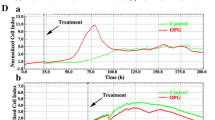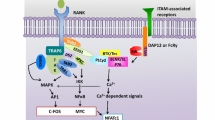Abstract
The P2X7 receptor (P2X7R) has been implicated in the process of multinucleation and cell fusion. We have previously demonstrated that blockade of P2X7Rs on osteoclast precursors using a blocking antibody inhibited multinucleated osteoclast formation in vitro, but that P2X7R KO mice maintain the ability to form multinucleated osteoclasts. This apparent contradiction of the role the P2X7R plays in multinucleation has prompted us to examine the effect of the most commonly used and recently available P2X7R antagonists on osteoclast formation and function. When added to recombinant RANKL and M-CSF human blood monocytes cultures, all but one compound, decreased the formation and function of multinucleated TRAP-positive osteoclasts in a concentration-dependent manner. These data provide further evidence for the role of the P2X7R in the formation of functional human multinucleated osteoclasts and highlight the importance of selection of antagonists for use in long-term experiments.





Similar content being viewed by others
References
Rassendren F, Buell GN, Virginio C, Collo G, North RA, Surprenant A (1997) The permeabilizing ATP receptor, P2X7. Cloning and expression of a human cDNA J Biol Chem 272:5482–5486
Chessell IP, Michel AD, Humphrey PP (1998) Effects of antagonists at the human recombinant P2X7 receptor. Br J Pharmacol 124:1314–1320
Di Virgilio F (1995) The P2Z purinoceptor: an intriguing role in immunity, inflammation and cell death. Immunol Today 16:524–528
Surprenant A, Rassendren F, Kawashima E, North RA, Buell G (1996) The cytolytic P2Z receptor for extracellular ATP identified as a P2X receptor (P2X7). Science 272:735–738
Ferrari D, Chiozzi P, Falzoni S, Dal Susino M, Melchiorri L, Baricordi OR, Di Virgilio F (1997) Extracellular ATP triggers IL-1 beta release by activating the purinergic P2Z receptor of human macrophages. J Immunol 159:1451–1458
Zheng LM, Zychlinsky A, Liu CC, Ojcius DM, Young JD (1991) Extracellular ATP as a trigger for apoptosis or programmed cell death. J Cell Biol 112:279–288
Di Virgilio F, Falzoni S, Chiozzi P, Sanz JM, Ferrari D, Buell GN (1999) ATP receptors and giant cell formation. J Leukoc Biol 66:723–726
Marks S Jr, Gartland A, Odgren P (2004) Skeletal development. In: Martini L (ed) Encyclopaedia of endocrinology and endocrine diseases. Academic, San Diego, pp 261–272
Biskobing DM, Fan X, Rubin J (1995) Characterization of MCSF-induced proliferation and subsequent osteoclast formation in murine marrow culture. J Bone Miner Res 10:1025–1032
Fujikawa Y, Quinn J, Sabokbar A, McGee J, Athanasou N (1996) Human osteoclasts differentiate from a sub-population of circulating monocytes. J Bone Miner Res 11:M399
Lacey DL, Timms E, Tan HL, Kelley MJ, Dunstan CR, Burgess T, Elliott R, Colombero A, Elliott G, Scully S, Hsu H, Sullivan J, Hawkins N, Davy E, Capparelli C, Eli A, Qian YX, Kaufman S, Sarosi I, Shalhoub V, Senaldi G, Guo J, Delaney J, Boyle WJ (1998) Osteoprotegerin ligand is a cytokine that regulates osteoclast differentiation and activation. Cell 93:165–176
Gartland A, Gallagher J, Bowler W (2000) Expression of the pore-forming P2X7 receptor by human giant cell tumour, osteoclasts and human RANKL-generated osteoclasts. J Bone Miner Res 15:361–369
Hoebertz A, Townsend-Nicholson A, Glass R, Burnstock G, Arnett TR (2000) Expression of P2 receptors in bone and cultured bone cells. Bone 27:503–510
Modderman WE, Weidema AF, Vrijheid-Lammers T, Wassenaar AM, Nijweide PJ (1994) Permeabilization of cells of hemopoietic origin by extracellular ATP4-: elimination of osteoclasts, macrophages, and their precursors from isolated bone cell populations and fetal bone rudiments. Calcif Tissue Int 55:141–150
Naemsch LN, Dixon SJ, Sims SM (2001) Activity-dependent development of P2X7 current and Ca2+ entry in rabbit osteoclasts. J Biol Chem 276:39107–39114
Buell G, Chessell IP, Michel AD, Collo G, Salazzo M, Herren S, Gretener D, Grahames C, Kaur R, Kosco-Vilbois MH, Humphrey PP (1998) Blockade of human P2X7 receptor function with a monoclonal antibody. Blood 92:3521–3528
Gartland A, Buckley KA, Bowler WB, Gallagher JA (2003) Blockade of the pore-forming P2X7 receptor inhibits formation of multinucleated human osteoclasts in vitro. Calcif Tissue Int 73:361–369
Gartland A, Buckley KA, Hipskind RA, Perry MJ, Tobias JH, Buell G, Chessell I, Bowler WB, Gallagher JA (2003) Multinucleated osteoclast formation in vivo and in vitro by P2X7 receptor-deficient mice. Crit Rev Eukaryot Gene Expr 13:243–253
Ke HZ, Qi H, Weidema AF, Zhang Q, Panupinthu N, Crawford DT, Grasser WA, Paralkar VM, Li M, Audoly LP, Gabel CA, Jee WS, Dixon SJ, Sims SM, Thompson DD (2003) Deletion of the P2X7 nucleotide receptor reveals its regulatory roles in bone formation and resorption. Mol Endocrinol 17:1356–1367
Li J, Liu D, Ke HZ, Duncan RL, Turner CH (2005) The P2X7 nucleotide receptor mediates skeletal mechanotransduction. J Biol Chem 280:42952-42959
Jorgensen NR, Henriksen Z, Sorensen OH, Eriksen EF, Civitelli R, Steinberg TH (2002) Intercellular calcium signaling occurs between human osteoblasts and osteoclasts and requires activation of osteoclast P2X7 receptors. J Biol Chem 277:7574–7580
Alcaraz L, Baxter A, Bent J, Bowers K, Braddock M, Cladingboel D, Donald D, Fagura M, Furber M, Laurent C, Lawson M, Mortimore M, McCormick M, Roberts N, Robertson M (2003) Novel P2X7 receptor antagonists. Bioorg Med Chem Lett 13:4043–4046
Stokes L, Jiang LH, Alcaraz L, Bent J, Bowers K, Fagura M, Furber M, Mortimore M, Lawson M, Theaker J, Laurent C, Braddock M, Surprenant A (2006) Characterization of a selective and potent antagonist of human P2X(7) receptors, AZ11645373. Br J Pharmacol 149:880–887
Matsuzaki K, Udagawa N, Takahashi N, Yamaguchi K, Yasuda H, Shima N, Morinaga T, Toyama Y, Yabe Y, Higashio K, Suda T (1998) Osteoclast differentiation factor (ODF) induces osteoclast-like cell formation in human peripheral blood mononuclear cell cultures. Biochem Biophys Res Commun 246:199–204
van’t Hof RJ, Tuinenburg-Bol Raap AC, Nijweide PJ (1995) Induction of osteoclast characteristics in cultured avian blood monocytes; modulation by osteoblasts and 1, 25-(OH)2 vitamin D3. Int J Exp Pathol 76:205–214
Walsh CA, Beresford JN, Birch MA, Boothroyd B, Gallagher JA (1991) Application of reflected light microscopy to identify and quantitate resorption by isolated osteoclasts. J Bone Miner Res 6:661–671
Buckley KA, Chan BY, Fraser WD, Gallagher JA (2005) Human osteoclast culture from peripheral blood monocytes: phenotypic characterization and quantitation of resorption. Methods Mol Med 107:55–68
Buckley KA, Hipskind RA, Gartland A, Bowler WB, Gallagher JA (2002) Adenosine triphosphate stimulates human osteoclast activity via upregulation of osteoblast-expressed receptor activator of nuclear factor-kappa B ligand. Bone 31:582–590
Chan BY, Gartland A, Wilson PJ, Buckley KA, Dillon JP, Fraser WD, Gallagher JA (2007) PPAR agonists modulate human osteoclast formation and activity in vitro. Bone 40:149–159
Gartland A, Ginty A, Gallagher J, Bowler W (1999) Activation of P2X7 receptors expressed by human osteoclastoma modulates bone resorption. Calcif Tissue Int 64:S56
Steinberg TH, Heiken JF (2007) P2 receptors in macrophage fusion and osteoclast formation. Purinergic Signalling 3:53–57
Falzoni S, Chiozzi P, Ferrari D, Buell G, Di Virgilio F (2000) P2X(7) receptor and polykarion formation. Mol Biol Cell 11:3169–3176
Donnelly-Roberts DL, Jarvis MF (2007) Discovery of P2X7 receptor-selective antagonists offers new insights into P2X7 receptor function and indicates a role in chronic pain states. Br J Pharmacol 151:571–579
Nelson DW, Gregg RJ, Kort ME, Perez-Medrano A, Voight EA, Wang Y, Grayson G, Namovic MT, Donnelly-Roberts DL, Niforatos W, Honore P, Jarvis MF, Faltynek CR, Carroll WA (2006) Structure-activity relationship studies on a series of novel, substituted 1-benzyl-5-phenyltetrazole P2X7 antagonists. J Med Chem 49:3659–3666
Ferrari D, Chiozzi P, Falzoni S, Hanau S, Di Virgilio F (1997) Purinergic modulation of interleukin-1 beta release from microglial cells stimulated with bacterial endotoxin. J Exp Med 185:573–582
Murgia M, Hanau S, Pizzo P, Rippa M, Di Virgilio F (1993) Oxidized ATP. An irreversible inhibitor of the macrophage purinergic P2Z receptor. J Biol Chem 268:8199–8203
Gargett CE, Wiley JS (1997) The isoquinoline derivative KN-62 a potent antagonist of the P2Z-receptor of human lymphocytes. Br J Pharmacol 120:1483–1490
Michel AD, Ng SW, Roman S, Clay WC, Dean DK, Walter DS (2009) Mechanism of action of species-selective P2X(7) receptor antagonists. Br J Pharmacol 156:1312–1325
Schilling WP, Wasylyna T, Dubyak GR, Humphreys BD, Sinkins WG (1999) Maitotoxin and P2Z/P2X(7) purinergic receptor stimulation activate a common cytolytic pore. Am J Physiol 277:C766–C776
Gallagher JA, Buckley KA (2002) Expression and function of P2 receptors in bone. J Musculoskelet Neuronal Interact 2:432–439
Gartland A, Buckley KA, Hipskind RA, Bowler WB, Gallagher JA (2003) P2 receptors in bone—modulation of osteoclast formation and activity via P2X7 activation. Crit Rev Eukaryot Gene Expr 13:237–242
Orriss IR, Knight GE, Ranasinghe S, Burnstock G, Arnett TR (2006) Osteoblast responses to nucleotides increase during differentiation. Bone 39:300–309
Acknowledgments
The authors thank the Arthritis Research Campaign for funding (KAB, ref G0566). AA, AG and JAG were kindly supported by the European Commission under the 7th Framework Programme (proposal #202231) performed as a collaborative project among the members of the ATPBone Consortium (Copenhagen University, University College London, University of Maastricht, University of Ferrara, University of Liverpool, University of Sheffield, and Université Libre de Bruxelles), and is a sub study under the main study “Fighting osteoporosis by blocking nucleotides: purinergic signalling in bone formation and homeostasis”. We would also like to thank Dr. W.B. Bowler for his support of this project.
Author information
Authors and Affiliations
Corresponding author
Rights and permissions
About this article
Cite this article
Agrawal, A., Buckley, K.A., Bowers, K. et al. The effects of P2X7 receptor antagonists on the formation and function of human osteoclasts in vitro. Purinergic Signalling 6, 307–315 (2010). https://doi.org/10.1007/s11302-010-9181-z
Received:
Accepted:
Published:
Issue Date:
DOI: https://doi.org/10.1007/s11302-010-9181-z




